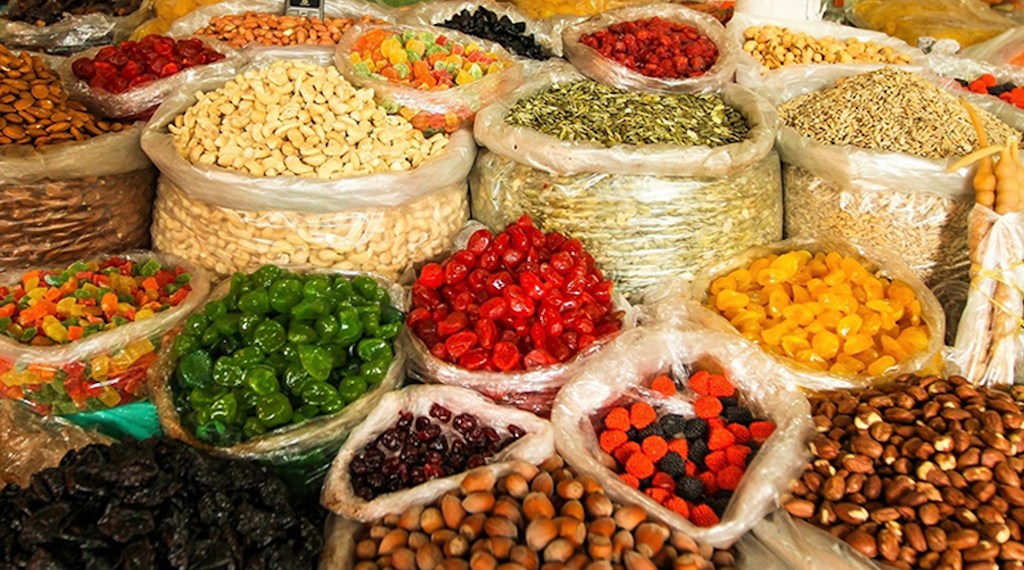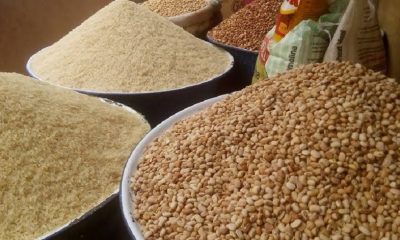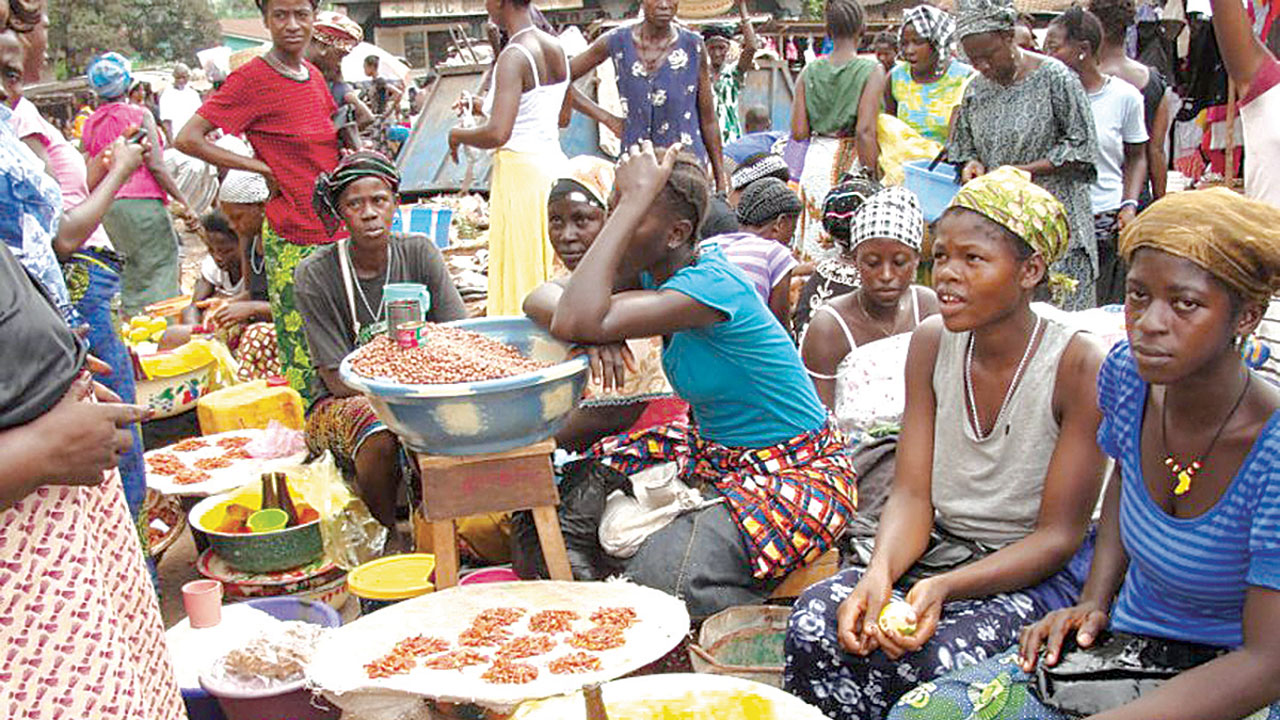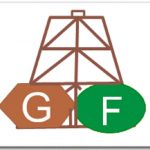World
Global Food Prices Surge in May to Highest Level Since 2011

By Adedapo Adesanya
The prices of food globally rose to their highest monthly rate since September 2011, led by oils, sugar and cereals, according to the Food and Agriculture Organisation (FAO).
This was contained in the FAO Food Price Index report released on Thursday, as the index tracked the international prices of the most commonly traded food commodities.
The FAO Food Price Index averaged 127.1 points in May 2021, 4.8 per cent higher than in April and as much as 39.7 per cent above the same period last year.
According to the United Nations agency, “The May increase represented the biggest month-on-month gain since October 2010.
“It also marked the twelfth consecutive monthly rise in the value of the food prices Index to its highest value since September 2011, bringing the Index only 7.6 per cent below its peak value of 137.6 points registered in February 2011.
“The sharp increase in May reflected a surge in prices for oils, sugar and cereals along with firmer meat and dairy prices.”
The FAO Vegetable Oil Price Index averaged 174.7 points in May, gaining 7.8 per cent month-on-month and marking a twelfth consecutive monthly rise.
According to the report, “The continued strength of the index mainly reflects rising palm, soy and rapeseed oil values. International palm oil quotations remained on an upward trajectory in May and reached their highest level since February 2011, as slow production growth in Southeast Asian countries together with rising global import demand, kept inventories in leading exporting nations at relatively low levels.
“As for soy oil, prospects of robust global demand, especially from the biodiesel sector, lent support to prices, while international rapeseed oil values were underpinned by continued global supply tightness.”
The FAO Sugar Price Index averaged 106.7 points in May, up 6.8 per cent from April marking the second consecutive monthly increase and the highest level since March 2017.
“The rise in international sugar price quotations was mostly related to harvest delays and concerns over reduced crop yields in Brazil, the world’s largest sugar exporter, as the prolonged dry weather conditions impacted crop development.
“Additional support was provided by higher crude oil prices and a further strengthening of the Brazilian Real against the US dollar, which tends to restrain shipments from Brazil.
Large export volumes from India, however, contributed to easing the price surge and prevented larger monthly price gains,” it said.
In the report, FAO Cereal Price Index averaged 133.1 points in May, up 6.0 per cent from April and 36.6 per cent above its May 2020 value.
Among the major cereals, international maize prices rose the most, gaining 8.8 per cent in May, reaching 89.3 per cent above their value last year and their highest level since January 2013.
It said towards the end of the month, maize prices started to retreat, mostly in expectation of higher production prospects in the United States.
The report read: “International barley and sorghum prices also increased in May, rising by 5.4 per cent and 3.6 per cent, respectively. Wheat prices still averaged 6.8 per cent up from April and 28.5 per cent above May 2020.
“While International rice prices held steady in May, with logistics and shipping costs keeping trading activity subdued through the month.”
It said the FAO Meat Price Index averaged 105.0 points in May, up 2.2 per cent from April, registering the eighth monthly increase and lifting the index 10 per cent above its level of one year ago, but still, nearly 12 per cent below its peak reached in August 2014.
“In May, price quotations for all meat types represented in the index rose, principally underpinned by a faster pace of import purchases by East Asian countries, mainly China.
“Tightening global supplies also provided price support across all meat products, reflecting multiple factors ranging from slaughter slowdowns in the cases of bovine and ovine meats to rising internal demand for poultry and pig meats in leading producer regions,” it said.
The report said the FAO Dairy Price Index averaged 120.8 points in May, up 1.5 per cent from April, marking one year of uninterrupted increases and lifting the value 28 per cent above its level of one year ago.
“However, the index is still 22.8 per cent below its peak value reached in December 2013.
In May, international quotations for skim milk powder rose the most, reflecting solid import demand amid limited spot supplies from the European Union, and those for whole milk powder increased on high import purchases, especially by China, despite New Zealand’s offer of large sales.
It said: “By contrast, butter prices fell on increased export supplies from New Zealand, marking the end of an eleven-month long price rally.”
World
Russia Renews Africa’s Strategic Action Plan

By Kestér Kenn Klomegâh
At the end of an extensive consultation with African foreign ministers, Russian Foreign Minister, Sergey Lavrov, has emphasized that Moscow would advance its economic engagement across Africa, admittedly outlining obstacles delaying the prompt implementation of several initiatives set forth in Strategic Action Plan (2023-2026) approved in St. Petersburg during the Russia-Africa Summit.
The second Ministerial Conference, by the Russian Foreign Ministry with support from Roscongress Foundation and the Arab Republic of Egypt, marked an important milestone towards raising bilateral investment and economic cooperation.
In Cairo, the capital city of the Arab Republic of Egypt, Lavrov read out the final resolution script, in a full-packed conference hall, and voiced strong confidence that Moscow would achieve its strategic economic goals with Africa, with support from the African Union (AU) and other Regional Economic blocs in the subsequent years. Despite the complexities posed by the Russia-Ukraine crisis, combined with geopolitical conditions inside the African continent, Moscow however reiterated its position to take serious steps in finding pragmatic prospects for mutual cooperation and improve multifaceted relations with Africa, distinctively in the different sectors: in trade, economic and investment spheres, education and culture, humanitarian and other promising areas.
The main event was the plenary session co-chaired by Russian Foreign Minister Sergey Lavrov and Egyptian Minister of Foreign Affairs, Emigration, and Egyptians Abroad Bashar Abdelathi. Welcome messages from Russian President Vladimir Putin and Egyptian President Abdelhak Sisi were read.
And broadly, the meeting participants compared notes on the most pressing issues on the international and Russian-African agendas, with a focus on the full implementation of the Russia-Africa Partnership Forum Action Plan for 2023-2026, approved at the second Russia-Africa Summit in St. Petersburg in 2023.
In addition, on the sidelines of the conference, Lavrov held talks with his African counterparts, and a number of bilateral documents were signed. A thematic event was held with the participation of Russian and African relevant agencies and organizations, aimed at unlocking the potential of trilateral Russia-Egypt-Africa cooperation in trade, economic, and educational spheres.
With changing times, Africa is rapidly becoming one of the key centers of a multipolar world order. It is experiencing a second awakening. Following their long-ago political independence, African countries are increasingly insisting on respect for their sovereignty and their right to independently manage their resources and destiny. Based on these conditions, it was concluded that Moscow begins an effective and comprehensive work on preparing a new three-year Cooperation and Joint Action Plan between Russia and Africa.
Moreover, these important areas of joint practical work are already detailed in the Joint Statement, which was unanimously approved and will serve as an important guideline for future work. According to reports, the Joint Statement reflects the progress of discussions on international and regional issues, as well as matters of global significance.
Following the conference, the Joint Statement adopted reflects shared approaches to addressing challenges and a mutual commitment to strengthening multifaceted cooperation with a view to ensuring high-quality preparation for the third Russia-Africa Summit in 2026.
On December 19-20, the Second Ministerial Conference of the Russia-Africa Partnership Forum was held in Cairo, Egypt. It was held for the first time on the African continent, attended by heads and representatives of the foreign policy ministries of 52 African states and the executive bodies of eight regional integration associations.
World
TikTok Signs Deal to Avoid US Ban

By Adedapo Adesanya
Social media platform, TikTok’s Chinese owner ByteDance has signed binding agreements with United States and global investors to operate its business in America.
Half of the joint venture will be owned by a group of investors, including Oracle, Silver Lake and the Emirati investment firm MGX, according to a memo sent by chief executive, Mr Shou Zi Chew.
The deal, which is set to close on January 22, 2026 would end years of efforts by the US government to force ByteDance to sell its US operations over national security concerns.
It is in line with a deal unveiled in September, when US President Donald Trump delayed the enforcement of a law that would ban the app unless it was sold.
In the memo, TikTok said the deal will enable “over 170 million Americans to continue discovering a world of endless possibilities as part of a vital global community”.
Under the agreement, ByteDance will retain 19.9 per cent of the business, while Oracle, Silver Lake and Abu Dhabi-based MGX will hold 15 per cent each.
Another 30.1 per cent will be held by affiliates of existing ByteDance investors, according to the memo.
The White House previously said that Oracle, which was co-founded by President Trump’s supporter Larry Ellison, will license TikTok’s recommendation algorithm as part of the deal.
The deal comes after a series of delays.
Business Post reported in April 2024 that the administration of President Joe Biden passed a law to ban the app over national security concerns, unless it was sold.
The law was set to go into effect on January 20, 2025 but was pushed back multiple times by President Trump, while his administration worked out a deal to transfer ownership.
President Trump said in September that he had spoken on the phone to China’s President Xi Jinping, who he said had given the deal the go ahead.
The platform’s future remained unclear after the leaders met face to face in October.
The app’s fate was clouded by ongoing tensions between the two nations on trade and other matters.
World
United States, Russia Resolving Trade Issues, Seeking New Business Opportunities

By Kestér Kenn Klomegâh
Despite the complexities posed by Russia-Ukraine crisis, United States has been taking conscious steps to improve commercial relations with Russia. Unsurprisingly, Russia, on the other hand, is also moving to restore and normalise its diplomacy, negotiating for direct connections of air-routes and passionate permission to return its diplomats back to Washington and New York.
In the latest developments, Kirill Dmitriev, Chief Executive Officer of the Russian Direct Investment Fund (RDIF), has been appointed as Russian President’s Special Envoy to United States. This marked an important milestone towards raising bilateral investment and economic cooperation. Russian President Vladimir Putin tasked him to exclusively promote business dialogue between the two countries, and further to negotiate for the return of U.S. business enterprises. According to authentic reports, United States businesses lost $300+ bn during this Russia-Ukraine crisis, while Russia’s estimated 1,500 diplomats were asked to return to Moscow.
Strategically in late November 2025, the American Chamber of Commerce in Russia (AmCham) has awarded Kirill Dmitriev, praised him for calculated efforts in promoting positive dialogue between the United States and Russia within the framework decreed by President Vladimir Putin. Chief Executive Officer of Russian Direct Investment Fund (RDIF) Kirill Dmitriev is the Special Representative of the Russian President for Economic Cooperation with Foreign Countries. Since his appointment, his primary focus has been on United States.
“Received an American Chamber of Commerce award ‘For leadership in fostering the US-Russia dialogue,’” Dmitriev wrote on his X page, in late November, 2025. According to Dmitriev, more than 150 US companies are currently operating in Russia, with more than 70% of them being present on the Russian market for over 25 years.
In addition, Chamber President Sergey Katyrin and American Chamber of Commerce in Russia (AmCham) President Robert Agee have also been discussing alternatives pathways to raise bilateral business cooperation. Both have held series of meetings throughout this year, indicating the the importance of sustaining relations as previously. Expectedly, the Roscongress Foundation has been offered its platforms during St. Petersburg International Economic (SPIEF) for the American Chamber of Commerce (AmCham).
On December 9, Sergey Katyrin and Robert Agee noted that, despite existing problems and non-economic obstacles, the business communities of Russia and the United States proceed from the necessity of maintaining professional dialogue. Despite the worsening geopolitical conditions, Sergey Katyrin and Robert Agee noted the importance of preserving stable channels of trade and pragmatic prospects for economic cooperation. These will further serve as a stabilizing factor and an instrument for building mutual trust at the level of business circles, industry associations, and the expert community.
The American Chamber of Commerce (AmCham) will be working in the system of the Chamber of Commerce and Industry (CCI) in the Russian Federation, which currently comprises 57,000 legal entities, 130 regional chambers and a combined network of representative offices covering more than 350 points of presence.
According to reports obtained by this article author from the AmCham, promising sectors for Russian-American economic cooperation include healthcare and the medical industry, civil aviation, communications/telecom, natural resource extraction, and energy/energy equipment. The United States and Russia have, more or less, agreed to continue coordinating their work to facilitate the formation of a more favorable environment for Russian and American businesses, reduce risks, and strengthen business ties. Following the American-Russian Dialogue, a joint statement and working documents were adopted.
-

 Feature/OPED6 years ago
Feature/OPED6 years agoDavos was Different this year
-
Travel/Tourism9 years ago
Lagos Seals Western Lodge Hotel In Ikorodu
-

 Showbiz3 years ago
Showbiz3 years agoEstranged Lover Releases Videos of Empress Njamah Bathing
-

 Banking7 years ago
Banking7 years agoSort Codes of GTBank Branches in Nigeria
-

 Economy3 years ago
Economy3 years agoSubsidy Removal: CNG at N130 Per Litre Cheaper Than Petrol—IPMAN
-

 Banking3 years ago
Banking3 years agoFirst Bank Announces Planned Downtime
-

 Banking3 years ago
Banking3 years agoSort Codes of UBA Branches in Nigeria
-

 Sports3 years ago
Sports3 years agoHighest Paid Nigerian Footballer – How Much Do Nigerian Footballers Earn






















